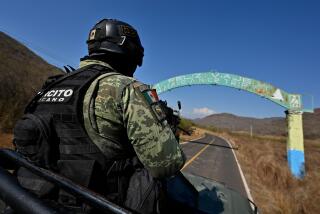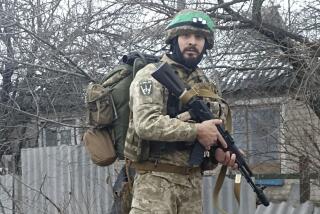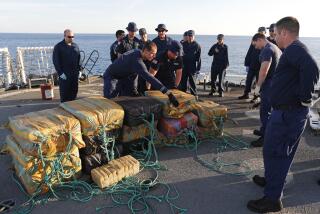Rebels Kill 14 Troops in Raid on Colombian Military Facility
BOGOTA, Colombia — In the bloodiest raid on Colombian armed forces in more than a year, leftist rebels killed 14 troops and wounded at least 25 on Tuesday in the southwestern province of Narino, a key battleground in this country’s 40-year civil war.
Authorities said the 29th Front of the Revolutionary Armed Forces of Colombia, or FARC, launched homemade rockets converted into mortar shells at a naval post near the Iscuande River about 2:40 a.m.
The navy said river gunboats, airplanes with heavy artillery and helicopters had been dispatched to pursue the rebels, who are waging a Marxist- inspired war largely financed with drug money.
Local television showed wounded troops being treated in nearby hospitals. Navy Adm. Mauricio Soto said that quick action by his men had prevented more casualties.
Narino is a major drug- producing province along the Pacific Ocean bordering Ecuador. The attack was said to have occurred along a corridor that the FARC uses to transport drugs.
Left-wing rebels belonging to another group, the National Liberation Army, also operate in the area.
The attack occurred near the site of a Jan. 13 helicopter crash that killed 20 Colombian soldiers on a nighttime counter-narcotics mission. That crash has tentatively been attributed to bad weather.
FARC attacks on Tuesday’s scale have become rare since President Alvaro Uribe took office 2 1/2 years ago promising to mount a major crackdown. Over the last year, Uribe launched Plan Patriot, a U.S.-backed military initiative that has sought to go on the offensive in southern guerrilla strongholds such as Narino. The government has stationed 17,000 troops in southern Colombia in an attempt to recapture territory long held by the FARC and seize its top commanders.
Under Uribe, kidnappings, homicides and bombings by the rebel group have dropped dramatically. But some analysts argue that the FARC has not been seriously weakened and is only in strategic retreat. Although large-scale rebel attacks have become unusual, the rebels still regularly harass police and ambush army patrols.
The attack “is a demonstration that the FARC maintains a military capacity that they aren’t using in a permanent way,” said military expert Alfredo Rangel, who heads the Foundation for Security and Democracy, a defense think tank in Bogota, the capital.
Rangel noted that a large portion of coca cultivation has been shifted to Narino because of massive U.S.-funded aerial fumigation programs in neighboring Putumayo province, which used to yield the bulk of the coca crop.
Many of those killed Tuesday were part of Uribe’s “peasant soldier” program, designed to expand the army rapidly to defeat the rebels. Unlike regular troops deployed across the country, these soldiers are stationed in their hometowns.
The government hoped these troops would provide better intelligence and spark good relations with local communities. Critics say, however, that they are inadequately trained. Still, the program had seen few casualties until Tuesday.
The U.S. has provided $3.3 billion in aid since 2000 to Colombia for anti-drug efforts and fighting rebel groups and the illegal right-wing paramilitaries who oppose them. Though U.S. troops are prohibited from participating directly in combat missions, they have trained Colombian forces. U.S. pilots also fly planes that spray illegal crops, and the U.S. government provided the Colombian army with loads of equipment.
Though FARC attacks on the armed forces have dropped, there have been significant incidents in the last year. In July, 13 soldiers died in Putumayo province in fighting between the armed forces and the FARC.
More to Read
Sign up for Essential California
The most important California stories and recommendations in your inbox every morning.
You may occasionally receive promotional content from the Los Angeles Times.










